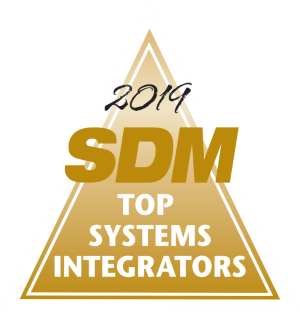A Sound Opportunity: Residential Intercoms & Audio Systems bounce Back Along With Construction
Construction is bouncing back, as are residential intercoms and audio systems.

Telephone dial boxes and gate operators can now be managed by a cloud-based IP backbone, such as the dwellingLIVE system offered by LiftMaster.

Telephone lines connect with intercoms behind the scenes in a large apartment building.

Formerly an ambulance, TMC TechPoint’s traveling showroom provides visibility at home shows, parades and other events.

The seventh-generation OmniTouch 7-in. touch screen monitor, which now uses the Android platform, expands intercoms beyond audio to control lighting, environmental and other systems.




The general construction market, which impacts the demand for residential intercoms and audio systems, has rebounded after several years in the doldrums. Timing is also good for the retrofit market to benefit the demand for residential intercoms. Systems installed during the building boom of gated communities in the 1990s are reaching the end of their life and likely ready to be retrofitted and upgraded. Both trends are bringing new intercom business to integrators, says David White, director of marketing, gate access systems, LiftMaster, Elmhurst, Ill. “The biggest challenge for dealers is to ramp back up in terms of growth in the business. Our residential business has come raging back.”
Like other sectors, intercoms and audio systems are being impacted by the move from analog to IP, says White. Telephone systems have already transitioned to voice-over-IP (VoIP), and intercoms will also eventually become part of an IP system — another edge device such as a camera or an access control reader.
LiftMaster, the professional products brand of the Chamberlain Group, signed an agreement to market dwellingLIVE, a cloud-based IP backbone that can be used to manage and track any transaction and any device, from a telephone dial box to a gate operator to radios, key fobs and card readers. At the beginning of next year, LiftMaster will roll out a new product portfolio of IP-based access control systems. Chamberlain also makes the Craftsman and Chamberlain brands of garage openers, smart-phone-based access and do-it-yourself intercom systems.
Helping to drive the transition to IP are U.S. telecommunications trends, including the bundling of Internet, TV and telephone service by a single provider using IP technology. “For dealers, it’s really important to get up to speed on IP-based notifications and communications,” says White. “It might not happen in 2016, but the phone companies are pushing for it.”
The next generation of technology is catching on very quickly, he adds. “Dealers must acquire networking skills to install the next generation of hardware.”
Slow Transition from Analog
For now, however, analog still makes up a lion’s share of the residential intercom market.
Gary Baker, vice president of marketing, Linear, Carlsbad, Calif., says the transition from analog to IP will happen gradually because many current analog systems meet the needs of the market. Linear’s VMC-1 video intercom, for example, can email a snapshot of a person ringing the doorbell to a smart phone or remote computer — a key feature many homeowners are looking for.
Despite the growth of IP networking, even in the residential sector, John Mosebar, vice president of marketing of Aiphone Corp., Bellevue, Wash., says there is still room for the simplicity of a standalone video intercom/entry system. “Sometimes it’s better to pull back,” he says. “There’s a lot of opportunity among people who don’t want it integrated together.” Mosebar says Aiphone’s solutions provide an inexpensive way to enhance residential security. He sees less demand for intercoms to communicate between rooms in a house. Rather, the devices are for security at the front door or at an entrance gate, he says, and most include video.
Aiphone provides video intercoms for single-family applications, including the seven-inch JO (touch button) and the JM series (touch screen) video intercoms. For multi-tenant buildings, Aiphone offers the GT series multi-tenant color video entry system. The stand-alone, hard-wired systems are not tied to a telephone system.
Another supplier, DoorKing Inc., Inglewood, Calif., offers telephone intercom systems that provide a communication path from a front door or gate via telephone lines. “It’s an alternative to a standard, hard-wired intercom system,” says Richard Sedivy, DoorKing’s director of marketing and regulatory affairs. Using telephone lines avoids an integrator having to run additional wires in the house for a stand-alone intercom; there is no hardware to install inside the house. Dealers enjoy a lower cost and easier installs versus a separate intercom system.
Instead of using a door release button like an intercom, the telephone systems enable users to unlock doors or gates by pressing 9 on the telephone. A house’s phone lines are routed through the DoorKing system. When someone presses a Push to Call button at the door or front gate, phones inside the house sound a distinctive double-ring. If a phone is in use, two short beeps sound over the line to signal there is someone at the door or front gate. The resident can then switch from their call to talk to the visitor and then switch back. Customers can access a system over the telephone to program in features such as “do not disturb” times.
DoorKing has similar products for multi-tenant buildings (that can also be used in commercial buildings). A directory listing guides a visitor to enter digits on a keypad to connect to a specific resident. The multi-tenant system can establish security permission levels and interface with elevator control functions. A system administrator can access the system over the Internet to change door key programs or other features. All local connections in a building are analog.
Leviton, Melville, N.Y., known for electrical products such as wall outlets and switches, entered the residential intercom business in 2012 with the acquisition of Home Automation Inc. (HAI). Leviton Security and Automation has released the seventh generation of its OmniTouch 7-in. touch-screen monitor, which now uses the Android mobile platform. Greg Rhoades, director of marketing, says Leviton’s plan is to expand intercoms beyond audio communication to control a range of related systems, such as lighting and environmental systems. A security button is always on the screen. The updated touch screen will be integrated with other devices and smart phones.
The touch screen can enable the integrator to provide added value to the user, such as programming a reminder to take out the recycling or to carry a coat if cold weather is forecast. The device can send an email or text to a parent when a latchkey child gets home safely, and even provide visual confirmation with a video image from an IP surveillance camera. Integrators can customize the touch screen to implement various features after evaluating a customer’s needs.
Distributed Audio Interfaces with i-Devices
Related to distributed audio, the Leviton Hi-Fi 2 distribution and amplification system connects to speakers throughout the house, providing multi-room audio with a paging function tied into the landline telephone (dial *87 to interrupt the music and speak to all the rooms). Music from iPods, iPads and other devices can augment or take the place of a music server, connecting through a ¹⁄8-in input jack in the wall or even wirelessly using a Bluetooth module to stream audio from any device or from Spotify, Pandora, etc.
Audio systems are moving toward wireless systems that incorporate the ability to integrate “i-devices,” says Tom Channel, product manager of distributor The Systems Depot, Hickory, N.C. The Systems Depot sells two systems that use WiFi to distribute music. The Sonos system provides compressed, MP3-quality music through the household WiFi network, while the Russound system provides uncompressed CD-quality sound through an audio-only WiFi network. (Customers using less expensive speakers may not be able to tell the difference, says Channel.) Integrators can benefit because connection and installation of a Russound system is not unlike installation of security panels and sensors, Channel says.
Channel cautions that dealers may be missing an opportunity by getting too comfortable selling the same, often entry-level, systems. He recommends dealers start by recommending a high-end system, and gradually “sell-down” to a level the customer is comfortable with. Selling down is easier than selling up. “If you start by suggesting the smallest, low-margin system, there is nowhere to go if there is a concern about price,” Channel says. “Choose a known brand, possibly a brand that has some American roots and has on-shore technical support rather than off-shore,” he recommends.
Specialization is a good way for dealers to differentiate themselves from the crowd of security integrators. Even if security is their core business, dealers can brand themselves as intercom or distributed audio specialists, a segment with fewer installers competing for business.
“Even if an integrator’s business is 90 percent security, they can invest $100 a month in Google AdWords to rank for ‘home intercom systems’ and other keywords to put themselves at the top of the list for any searches being done,” says Linear’s Baker. The keyword competition for intercoms is much less than for security systems, so it’s easier for a dealer to make it to the first page of a search, from which most people click. Geographic specialization, such as including words like “Texas” in front of “intercom systems,” can also result in better search rankings and more leads.
Dealers should educate themselves about the new integration and upsell options that go along with intercom systems. Accessories and subsystems such as door release mechanisms, cameras, and additional door stations are options, Baker shares. “What starts as a simple intercom can gradually turn into a basic home automation system that provides a good RMR opportunity,” he adds.
Dealers can also play up the dual functionality of intercom systems, which can serve as multi-room audio systems, playing AM/FM radio and digital music files anywhere an intercom is installed. “It’s a nice alternative to blocking out the family and wearing headphones all over the house,” says Baker.
Specialization Pays Off
TMC TechPoint has built a successful business by targeting a specific need in the intercom market — replacing aging intercoms in upscale residences in the Dallas, Texas, area. Most residential building in the Dallas-Ft. Worth metroplex in the early 1980s was custom homes, and most had intercom systems. As the homes get older, the intercoms need to be replaced, and TMC TechPoint specializes in doing the job using new systems by Linear/M&S. Newer intercoms are smaller and have more features, but they also include trim plates and panels that can fill the same-size hole to avoid having to redo wallpaper or paneling. (Linear acquired M&S Systems in 2004; both are owned by Nortek, Providence, R.I.)
“When you try to be everything to everybody, you don’t serve your customers well,” says Bob Corona, TMC TechPoint owner. “You’re not going to have enough people trained in specific areas to make a customer happy. I decided to specialize in two areas, and the customer satisfaction and rewards are much higher.” TMC TechPoint also replaces centralized vacuum systems in the Dallas area, with systems provided by Linear/M&S, too.
The narrow business focus presents fewer cost variables, which makes the business easier to manage, Corona shares. Marketing is also easier because he knows who the customer is. The dealer markets intercom and communication products by targeting neighborhoods, homeowners’ associations, real-estate professionals, remodelers and home shows. A traveling showroom boosts visibility in parades and at other events.
The flexibility of trim plates enables TMC TechPoint to replace 50 years of intercom designs from four manufacturers while accommodating existing 3-, 4-, 6- or 7-wire schemes. In addition to updating the analog systems, the new installs allow systems to accommodate MP3s, iPods and CD players. Newer systems also interface with video cameras, HVAC systems, lighting control, etc.; all integration is hard-wired and not IP-based.
A master intercom control unit, usually installed in the kitchen, directs background music and voice communications to room stations throughout the house. The main unit can be turned off, or music channels changed, from various room stations. Intercoms can allow parents to monitor their children playing in their rooms.
“We just tried to find a niche where we could deliver a high level of satisfaction, Corona says.
How Many Intercoms?
About 11 percent of broadband households have intercoms, including 8 percent that have intercoms at entry doors and 7 percent that have intercom stations inside the home, according to May 2013 research by Parks Associates, Dallas. The survey reflects responses from among the three-fourths of U.S. households equipped with broadband, or about 93 million households. The May survey did not specify if intercoms were IP-based.
Looking for a reprint of this article?
From high-res PDFs to custom plaques, order your copy today!











